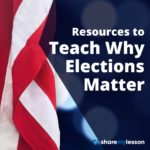This lesson looks at the contested presidential elections occurring in 1800, 1824, 1876 and 2000. Using C-SPAN video clips, students will identify how each election was resolved and the consequences of these elections. They will apply this knowledge by describing similarities and differences between these examples and determining what lessons can be learned from these elections.
Presidential Elections
The purpose of this lesson is to have students learn about each presidential election and presidential terms. Students will understand how various events in history shaped campaigns. Why elections were won and lost. What accomplishments and disappointments each president experienced. Each election and presidential term served had its own mark on history. The presentation to the class is the order of the elections starting with Washington’s first election and proceeding forward. The lesson plan was created to engage students in the election process and create interest in the coming presidential election.
Constituting America’s 90 Day Study of The Intrigue of Presidential Elections and Their Constitutional Impact is a resource guide for students. This study supplies many of the important facts and figures of each presidential campaign. There are also intriguing facts, stories, and information about the person, campaign, time in office and after the presidency.
Election: The Road to the White House (Secondary)
During an election, civic energy reaches a fever pitch. The vote is one of the citizen’s most powerful tools, and advocating for a candidate, a set of ideas, or a platform is the right of every citizen. The President of the United States is often called the most powerful person in the world, so with every presidential election, the stakes are high. This unit is designed to teach students about presidential elections. It is not a collection of facts, diagrams, and explanations of processes. It is an interactive, project-based unit that invites the student to fully engage in the process of an election while also informing students about how elections work. It is our hope that this unit helps cultivate the sorts of informed and engaged citizens that are so essential to our democracy.
Election: The Road to the White House (Elementary)
This unit is designed to teach students about presidential elections. It is not a collection of facts, diagrams, and explanations of processes. It is an interactive, project-based unit that invites the student to fully engage in the process of an election while also informing students about how elections work. It is our hope that this unit helps cultivate the sorts of informed and engaged citizens that are so essential to our democracy.
Midterm Elections Matter
This lesson is intended to help students understand that midterm elections (whether they be for congressional candidates, governor, state representatives, or state initiatives) are equally as important as the presidential race every four years.
Civic Education and Election Resources

It’s election season in the United States and a good time for students to understand why local and national politics matter and the core principles on how our democracy and elections works. What is gerrymandering? How can we strengthen our democracy? Plan how to answer questions like these as Election Day draws closer. Use these free K-12 civic education lessons, activities, blogs and webinars to help you educate students on the election and the importance of counting every vote. Additional topics include fostering civil discourse, fighting fake news, voting rights and debate ideas to keep your students informed and engaged.
Flaws of the Electoral College System
In this activity, students will trace the history of the Electoral College through analysis of primary source documents from the elections of 1789, 1800, 1824, and 1988 to identify four flaws with the system. An examination of proposed and implemented reforms, including the 12th Amendment, will engage students in a discussion of modifying or abolishing the Electoral College.
The Electoral College Process
In this activity, students will learn the steps in the Electoral College process, from Election Day to Inauguration Day. They will analyze historical primary sources from various Presidential elections, each representing a different step in the process, and arrange them in the correct sequence.
Voting by Mail
Because of concerns over COVID-19, many states may ask people to vote by mail this year. Are your students ready to vote on Election Day 2020? Let students see what a mail-in ballot process is like, and discover the advantages and disadvantages of mail-in elections.
Contested Ballots: You Be the Judge
This lesson uses the example of the 2008 contested Senate election between Al Franken and Norm Coleman in Minnesota to discuss contested elections, counting votes, and recount laws. Looks at recount laws in your own state.